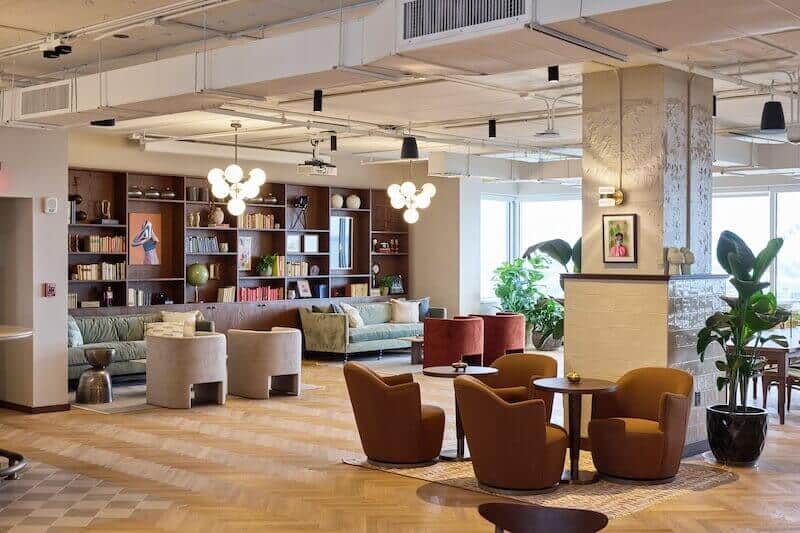
Commercial Sublease vs Traditional Lease vs Coworking: Differences
If you’re in the market for a new base of operations, you’ll want to consider all available options to ensure you’re getting the best deal. However, most people start and end their search with traditional leases. Restrictive and expensive, traditional office leases can put a serious dent in your bottom line, while many spaces simply aren’t fit for purpose.
However, subleasing office space is something to think about if you’re looking for shorter-term arrangements and lower rental prices. Coworking spaces provide another worthwhile solution, with venues designed for collaboration and creativity. Not sure which lease option is right for you? Read on as we attempt to settle the coworking vs traditional office vs commercial sublease argument for good.
TLDR: Let’s discuss the main differences between Commercial Sublease vs Traditional Lease vs Coworking.
| Aspect | Traditional Office Lease | Commercial Sublease | Coworking Space |
|---|---|---|---|
| Flexibility | Low – and Long-term, restrictive leases | Medium – Shorter terms are possible, but renewal is uncertain | High – Monthly or even daily terms, easy scaling |
| Costs | High Upfront costs, utilities, maintenance, fit-outs | Medium – Lower than traditional lease, but deposits and fees apply | All-inclusive pricing; lower upfront costs, but can add up over time |
| Privacy | High – Private spaces, dedicated entrances, client confidentiality | High (if subletting entire space); Medium (if partial) | Low to Medium – Shared spaces; private suites available in some venues |
| Facilities | Limited – Often need to arrange & pay for all facilities yourself | Medium – Shared access to common areas, depending on the agreement | High – Full access to ready-made shared facilities (meeting rooms, lounges) |
| Customization | High – Full control over branding, layout, and design | Low – Limited customization; changes need landlord approval | Medium – Some customization in private suites; shared areas are generic |
| Networking Opportunities | Low – Few organic opportunities; must create events yourself | Low – Unless sharing with other businesses | High – Daily exposure to diverse professionals; regular networking events |
| Growth Potential | High Control over space, but may lead to unused space if not planned | Medium – Possible to expand within sublease if available | Medium – Easy to scale, but limited to available space within the venue |
| Maintenance & Management | Self-managed; delays if the landlord is slow | Can experience delays due to layers (sublandlord and landlord) | Fast and managed by a coworking provider |
| Best For | Established companies need privacy, branding, and a stable base | Businesses needing short-term, private space at a lower cost | Startups, freelancers, and teams needing flexibility, community, and low setup hassle |
Things to Consider When Choosing the Right Office Space
When securing commercial real estate, it’s tempting to follow the lowest price and a convenient moving-in date. However, you’ll need to think beyond these perks when choosing a suitable space for your business.
Facilities
Workstations aside, any self-respecting business will need a location equipped with a slate of essential facilities. Aside from space for desks, will you need access to meeting and conference rooms? If so, will these spaces already have the audiovisual equipment you need? You might also require communal areas like breakout rooms, kitchens, and shared lounges.
Other everyday facilities include high-speed internet access, IT infrastructure, receptionist services, and more. However, depending on the type of commercial lease you secure, not all of these facilities may be included.
Costs
Cost also plays a central role in choosing the right office space for your requirements. A conventional commercial lease can be affordable enough, but you’ll also need to factor in additional costs for things like furniture, IT infrastructure, and utilities. With a co-working space, these shared facilities are typically included in the price, making them a more cost-effective alternative for many businesses.
Location
One of the most important things to consider when choosing the right office space is location. A central location in bustling business districts or trendy neighborhoods will allow you to remain competitive while enjoying ready access to nearby amenities and convenient transport links.
However, in recent years, there’s been a growing trend in the number of hyperlocal office spaces being procured. These office spaces are set apart from city centers, with suburban locations that are within easy reach of residential areas. While practical for the employee, these spaces are designed to benefit space users, rather than visiting clients and industry partners, so may not be an ideal fit for your organization.
Time Period
Many office leases will come with a set time period. In most cases, this will be 12 months or longer. However, in other scenarios, you may find yourself able to secure a month on a shorter basis, such as a 6-month contractual period.
While these short-term solutions can seem a flexible choice, bear in mind that you lose the security that a longer lease provides. Not ideal if you’re looking to bed down and establish yourself in a single location for the first year of operation.
Contract Terms and Conditions
Contractual obligations can vary considerably, depending on the type of lease agreement you have secured for an office space. Leases for traditional office spaces tend to be most restrictive, while those attached to coworking spaces are far more flexible, with plenty of freedom afforded by perks like rolling monthly subscriptions. Whatever type of lease you have secured, make sure you’ve referred to contractual terms and conditions before signing on the dotted line.
Privacy
Privacy and confidentiality are major concerns for businesses. Conventional office spaces tend to offer plenty in the way of privacy, with dedicated entrances and no worry about having to share facilities like meeting rooms and communal areas. Coworking space users do have to contend with some privacy concerns posed by shared spaces, but this issue can be mitigated by choosing team suites and private offices with private entrances.
Office Design
The traditional office space doesn’t work for everyone. An office interior dominated by banks of cubicles might suit some businesses, but others prefer a more collaborative setting. An open-plan design can help facilitate this, fostering collaboration and inspiring creativity.
What’s more, you’ll want to think about how office design impacts productivity and affects employee well-being. A space flooded with natural light is more likely to produce productive workers, while biophilic design can promote a sense of calm and improve focus.
Office Culture
The office you choose ultimately says a lot about your office culture. You’ll want to consider your shared beliefs, values, and behaviors when choosing a suitable space if you want to promote these to your employees.
When you choose a space that upholds your core values, you can expect increased productivity, more engaged employees, higher levels of employee satisfaction, and improved retention rates.
What is Commercial Subleasing?
Sometimes known as underletting, commercial subleasing is when a tenant engaged in a commercial lease agreement chooses to lease some or all of the property to another tenant. While the tenant becomes the landlord to the subletting tenants, they still have contractual obligations to the original landlord.
Not every tenant is eligible to sublease commercial office space. Sometimes, only a portion of the property may be subleased to other tenants, while other contracts allow for an entire property to be sublet. In other cases, subleasing of any kind may be prohibited.
Advantages of Subleasing Office Space
If you’re looking for an alternative to a traditional office lease, subleasing is definitely worth considering. Below are just a few of the perks you can expect when choosing to sublet a business premises from another tenant.
Shorter Lease
It can be difficult to find an office space with a short lease period. Fortunately, subleasing provides you with more flexibility in this regard. You’re far more likely to find a 6-month lease when choosing to underlet from another tenant, rather than strike out on your own when searching for commercial real estate.
Privacy
If you’re subletting an entire premises from another tenant, privacy concerns become a thing of the past. You won’t have to use common areas and shared spaces alongside employees from another company, giving you peace of mind when it comes to client confidentiality and everyday privacy.
Access to Common Areas
Even if you’re only subleasing part of a larger space, there are still benefits to be had. In coworking spaces, for example, you’ll be able to access shared facilities like conference and meeting rooms, while lounge areas and collaborative spaces provide plenty of networking opportunities.
Option to Take Entire Space
A subleasing agreement might start out with a tenant only taking a certain amount of office space, but there’s always the option to expand your requirement and take over an entire space. Original tenants may decide to downsize further, opt for hybrid work, or go fully remote. This provides you with the perfect opportunity to capitalize on more square footage, with all the freedom of a subleasing contract.
Drawbacks of Subleasing Office Space
It’s not all good news in the sublease vs lease debate. Despite plenty of notable benefits, there are a few drawbacks you’ll need to consider if you’re choosing to sublease an office.
Compatibility with Other Businesses
When you sublease, you might be sharing a space with a company or companies from completely different industry sectors. With different working styles and requirements, culture clashes and compatibility concerns are common.
Uncertain Renewal Options
The short-term and flexible nature of a sublease agreement might be beneficial at first, but you’re ultimately left with uncertainty when it comes to renewing your contract. If you’re looking for a long-term base of operations, subleasing might not be for you.
Fees for Damage Before Your Sublease
To cover any damages that might occur during your lease, you may have to pay a security deposit before moving into new premises. For businesses already worried about the bottom line, this is one cost that would be better off avoided.
Maintenance Delays
When you lease from a tenant who themselves lease from a landlord, communication takes longer. For example, resolving basic maintenance issues can take days or weeks, rather than being addressed within 48 hours.
Limited Customization Options
If you’re looking for premises you can customize to your liking, a sublet probably isn’t for you. You’ll be limited in what you can do with a sublet commercial space, with final approval having to come from the actual landlord, rather than the tenant you’ve agreed on a subleasing agreement with.
Sublease vs. Lease
Still not sure on whether to go with a subleasing agreement or play it safe with a traditional office lease? Below, we’ll weigh up the benefits and drawbacks of a traditional office lease to help you make your decision.
Advantages of a Traditional Office Lease
While they’re not as flexible as other alternatives, traditional office leases come with many benefits. Below are just a few of them.
Branding and Customizable Office Space
When you secure a traditional office lease, you’re not bound by restrictive contractual agreements regarding branding and customization. You’re free to put your mark on the place, helping you promote your company culture and send the right branding messages to visiting clients.
You’re also generally free to customize office spaces to your liking. If the current cubicle-based arrangement doesn’t work for you, you can adopt a more open-plan design instead. You can also
Trust and Professionalism
Making the right first impression with clients matters. A shared space or sublet premises doesn’t necessarily strike the right chord with visiting clients, whereas a dedicated space secured via a traditional lease can help build trust and present a professional image.
Total Privacy
With a standard office lease, you benefit from complete privacy. There’s no sharing of facilities and receptionist services, while you’ll have a dedicated entrance set apart from prying eyes. Perfect if you pride yourself on upholding client confidentiality or deal with sensitive material.
Growth and Transition
A traditional office lease can help nurture a fledgling business. Even if you quickly outgrow a space and its facilities, having a stable base of operations during the early stages of business is invaluable.
Drawbacks of a Traditional Office Lease
Traditional office leases may provide privacy, security, and peace of mind, but they’re not the best solution for every business. Below, we’ll explore some of the drawbacks that make traditional leases an unsuitable option for some.
Less Flexible Lease
Traditional office leases offer a lot of security, but this comes at a cost. Generally speaking, conventional leases are inflexible, with tenants tied into restrictive contractual obligations.
High Upfront Costs
Standard office spaces can be expensive. While overall rents may be affordable enough, there’s a significant upfront cost associated with a traditional lease. You’ll have to factor in moving costs, setting up office infrastructure, arranging utility providers, and more.
Location Constraints
It’s not always possible to find the perfect office space in a prime location, especially if you’re working with a modest budget.
Unused Space
With a traditional office, it might not be possible to extensively reconfigure and customize layouts. This can lead to a lot of unused space, which can be frustrating for tenants experiencing rapid growth and who are dealing with rising headcounts.
Fewer Opportunities to Network and Collaborate
While conventional office leases provide you with maximum privacy and dedicated use of spaces like meeting rooms, you do miss out on many perks associated with sublet premises and coworking spaces. Typically, there are very few chances to network with other businesses, unless you organize and host events yourself. What’s more, a limiting layout can make collaboration difficult.
Office Leases vs. Office Sharing
If you’re searching for yet another alternative to the usual office lease, why not consider giving office sharing a try? Coworking spaces are becoming increasingly popular, offering users a flexible workplace, access to first-rate facilities, and scalable solutions.

What is a Coworking Space?
A coworking space is a workspace that brings together freelancers, small businesses, and startups, providing them with a collaborative environment in which to work. A typical coworking venue may feature a large open-plan space with hot desks where individuals can work side by side.
Alternatively, some coworking spaces also feature team suites and private offices. Space users enjoy a complete suite of utilities, including high-speed internet access, business printing, and more. Coworking spaces also typically feature shared spaces like breakout rooms and meeting rooms, which can be enjoyed by any user of a coworking space.
Advantages of Coworking
If you’re prepared to experiment with something slightly different, coworking spaces are an ideal solution. Designed to encourage collaboration and promote productivity, coworking spaces are also scalable, readily customized, and cost-effective.
Flexibility
Nothing beats coworking when it comes to flexibility. Users have a range of subscription options, including affordable day passes and practical rolling monthly contracts. If you’re looking for a more flexible office that’s not tied up in restrictive leases, coworking spaces are an obvious win.
Short-term Usage
Only need a workspace for a short period? Whether it’s a single day of hot desking or the rental of a private suite as your team completes a project, coworking spaces are perfect for those looking for short-term solutions.
All-inclusive Service and Costs
Moving into a new business can be a costly endeavour. Once you’ve finalized furniture, set up contracts with utilities, and taken care of any other upfront costs, there’s generally very little left in the coffers. With coworking, you’ll only actually pay to use the space itself. All the upfront costs, including hidden ones, associated with a traditional lease simply aren’t a concern when you choose to cowork.
Accessibility
Accessibility is a legal obligation for any business. However, making adjustments to a rented office space can be costly and time-consuming. This isn’t something you have to worry about when using a coworking space, with such venues already kitted out with accessility-enhancing features.
Easy Move
Dreading a huge move from one office to the next? Rather than spend a fortune and countless hours ferrying items from your old place of business to your new one, move into a coworking space instead. You’ll have everything waiting for you, including quality desks, workstations, and ergonomic seating. Perfect if you plan on moving into new premises but are dealing with a tight timeframe.
Simplicity
Finding a new office space can be frustrating, with many businesses forced to look far and wide for the ideal space for them. Furthermore, lease agreements can prove almost impenetrable, making them confusing for prospective tenants. You’ve then to factor in the time to deal with utility providers and arrange deliveries for incoming furniture, servers, and other office essentials. A coworking space streamlines the process considerably. In fact, all you have to do is sign up for a space and you’re good to go.
Customization Options
Many coworking spaces can be customized to your liking. If you’re thinking of renting a team suite or private office, you’ll almost always be able to play around with interior configurations until you’ve found the perfect fit for your working methods.
Sense of Community and Networking
When you cowork, you benefit from becoming part of a larger community. On a daily basis, you’ll be working alongside all manner of professional features and smaller companies, with many occupying completely different industries. Shared spaces and networking mixers are a staple of coworking, providing you with plenty of opportunity to make friends and secure exciting new ventures.
Education Opportunities
Coworking spaces are great places to make your base if you’re looking to learn. Open-plan environments mean you connect with other professionals, who can offer you invaluable insights, teach you new skills, and suggest how you can improve your workflows. Additionally, many coworking spaces host regular knowledge-sharing and skills learning events.
Association and Collaboration
The typical office environment doesn’t do much to foster collaboration. With their open-plan interiors and communal areas, coworking spaces do. Ideal if you’re looking to join ranks with other companies to complete big projects.
On-demand Meeting and Event Spaces
Few offices have any additional spaces beyond a main work area and a breakout room. This leaves things like meeting rooms and event spaces an unattainable luxury. Well, that’s when you lease a traditional office anyway. Coworking spaces provide regular access to a host of shared facilities, including on-demand meeting rooms and larger spaces for hosting events.
Access to Facilities
Coworking locations grant you access to all the facilities you need to complete your tasks on time and keep profits rolling in. Alongside workstations, meeting rooms, and event spaces, you’ll also enjoy access to things like receptionist services, employee kitchens, and break areas.
Maintenance
If you’re leasing an office independently, you’ll understand the frustration of having to wait far too long for basic maintenance tasks to be completed. This isn’t something you’re going to have to lose sleep over when you choose a coworking instead. Expect a more proactive approach from coworking space providers, attending to problems so quickly you’ll barely have time to realize there was an issue in the first place.
Drawbacks of Coworking
It’s easy to understand the appeal of coworking. However, it’s not always the best solution for everyone. Below, we’ll explore some of the biggest issues holding coworking spaces back.
Lack of Complete Privacy
Because of their open-plan interiors, many coworking spaces have something of a privacy problem. This can be an issue if you’re dealing with sensitive clients or pitching to new ones. Fortunately, upgrading to private offices or team suites can sidestep this problem.
Lack of Complete Personalization
While many coworking spaces allow users to customize suites and private offices, general areas can’t really be personalized. The aim here is to cater to as broad a palette as possible, leaving little scope for customization.
Brand Image
Making the right first impression with prospective clients means maintaining a high degree of professionalism. A coworking space isn’t always the best venue for a first-time meeting with a client, especially if privacy is a concern.
Limited Growth
While startups and smaller businesses can scale their workspace requirements at coworking locations, there’s often no real growth opportunity for the individual. Those who commit to using a hot desk will probably be office hoteling indefinitely, unless they secure enough work to upgrade to a private office of their own.
Sharing Facilities
Access to shared facilities is great, but this apparent coworking perk isn’t without its thorns. On-demand facilities like meeting rooms are always popular, so you’ll need to be quick when requesting access.
Limited Storage Space
Coworking settings aren’t exactly full to the brim with storage space. For individual freelancers, the best they can often expect is a desk drawer. When hot desking, even this might be considered a premium. Many coworking providers do offer things like lockers, but there’s no real scope for things like large-scale storage of archived documents.
May Be More Expensive in the Long Term
While you’ll escape the hidden costs associated with regular office leases, coworking spaces aren’t always as economical as you might think. It can be expensive for individuals to use coworking spaces regularly, especially if they’re opting to use day passes. Monthly subscriptions are more cost-effective, but it’s here you’ll start to see the premium make its way into pricing.
Which Office Space is Right for You?
Looking to relocate your office to a new location? By now, you should have a pretty good idea about what’s available to you. If you’re searching for a long-term arrangement and don’t have a problem securing the upfront costs, a traditional office lease is a good option. If you’re looking for more flexibility with shorter contractual periods, commercial subleases are something to consider. However, here you’ll have to deal with uncertainty regarding the long-term usage of a space.
Coworking spaces are an innovative alternative to both standard leases and commercial subleases. Every type of professional and company is catered for by coworking spaces, with hot desks and dedicated workstations for the individual alongside team suites for startups.
You’ll also benefit from enjoying access to shared facilities that might normally be placed out of your price range. However, it’s the price of a coworking space that most impresses. Often cheaper than a normal office lease, the cost of coworking is even more appealing once you cross out all those hidden costs and budget-sapping utility bills.
Are you looking for a new place to do business? Rather than pay over the odds for a standard office setup or take a chance on an uncertain sublet, why not see what Mindspace’s flexible coworking locations have in store for you? We operate coworking spaces in some of the biggest and most-visited countries in the world, making us the obvious choice if you’re looking to make a big first impression and grow your business.
From private offices and team suites to dedicated desks and day bookings, there’s plenty of choice for those looking to explore coworking for the first time. Ready to start your journey towards finding the perfect coworking space for your requirements?
Explore our premium workspaces online today or get in touch to discuss booking a tour





